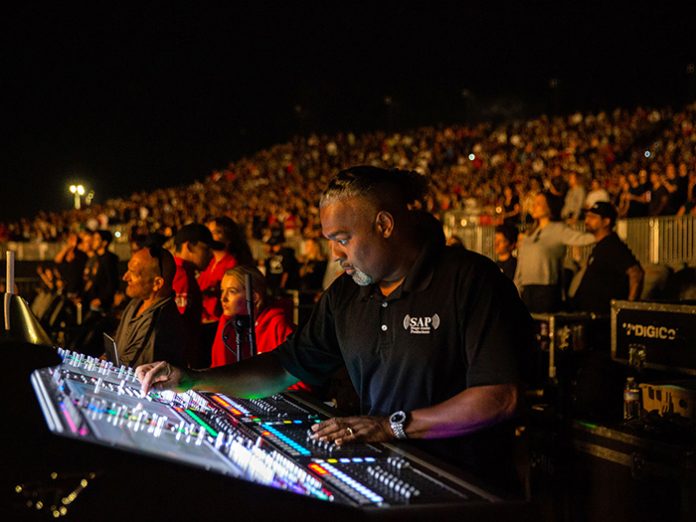FOH mixer Darcy Khan utilised an DiGiCo SD7 console for mixing Logic’s The Bobby Tarantino vs. Everybody 2018 Tour, featuring additional sound reinforcement in the shape of L-Acoustics.
While on the road Khan has had to deal with some soaring temperatures. “It was 114 degrees Fahrenheit (45 Celsius) in Phoenix when we were there,” recalled Khan, who’s also been the FOH mixer on tours for Kanye West and OutKast, and owns backline provider Stage Audio Productions in Atlanta. “It was hot!”
After watching the internal temperature of previous consoles edging as high as 118 (48C)—and watching global temperatures inching up over the last several years—Khan decided not to take any chances. “In the past, we had to bring out additional fans and dry ice to keep the console temperatures in check. The SD7 has never gotten above 107 degrees (42C). It’s never overheated, never had a failure.”
And the DigiCo SD7 has another feature that Khan finds critical during summer tours now: 2 processing engines, A and B, that are mirrored, so any failure is immediately and seamlessly picked up by the second engine. “First and foremost, I need reliable redundancy,” he said. “And the SD7 has that.”
Khan is also a fan of the DiGiCo SD7’s feature set. “Sometimes Logic cups the mic, sometimes he doesn’t, and I never know when, so the multiband compressor lets me keep up with him and keep the vocal level smooth,” he explained. Khan also commends the DiGiTube tube-emulator feature, available on every SD7 channel and buss thanks to Stealth Core 2 processing.
But Khan saves his biggest accolades for the DiGiCo SD7’s sonics. “What I love best is that I can run the console at 96 kHz,” he said. “The clarity of the vocal is incredible, and it’s consistent throughout the frequency range. I have the bottom down to 40 Hz through 32 subs, and plenty of low-mid and high-mid, and all of it is crystal clear. Intelligibility is at a hundred percent, from top to bottom. That’s an extreme challenge for a console, and the SD7 handles it easily.”
For most of the dates of The Bobby Tarantino vs. Everybody Tour, the audio crew is flying up to 18 enclosures per side in the main PA hangs—6 L-Acoustics K1 over 12 L-Acoustics K2—with 8 additional L-Acoustics K1 per side flown as outfill arrays.
A dozen flown L-Acoustics K1-SB and 20 ground-stacked L-Acoustics SB28 subwoofers deliver ample low end for the bass-heavy hip-hop shows, with 12 L-Acoustics Kara providing audience frontfill coverage from the stage lip. Monitor arrays are a pair of L-Acoustics ARCS II over 2 L-Acoustics SB28 subs, buttressed by a dozen wedges across the front of the stage. The full L-Acoustics complement is powered by a total of 39 L-Acoustics LA8 Amplified Controllers.
L-Acoustics was the best choice for what Logic wanted on the road, said Thunder Audio Vice President of Sales Greg Snyder, who designed the system with input from FOH Engineer Khan and Monitor Engineer Dane Tarmann. “What makes this system stand out is that it’s a hip-hop tour, but one that demanded high quality and high intelligibility top-to-bottom,” he said. “K1 and K2 give us all of that and let the system be configured to fit the wide variety of different venues it’s playing in.”
Tarmann, also running a DiGiCo SD7, not only managing the IEMs onstage but also using the SD7 as part of the intercom network, coordinating a dozen talkback microphones that keep the artist, the musicians and the crew interlinked on the production radios.
“It’s a way of working that I think is becoming more common in monitor world because it really facilitates communications before and during the shows,” he explained.
“What makes that possible, and what makes the SD7 such a great monitor console, is the flexibility of its workflow. Having the two fader banks on the centre tile is very helpful—I’m constantly moving between mixes and that lets me leave the VCA mix where I want it and just use the busses on top. I also do a lot of subgrouping of inputs before they hit the monitors, and the SD7 gives me a lot of flexibility for that, too. In fact, it’s why I use the SD7 in the first place—no other console gives me that kind of flexibility.”
DiGiCo SD7’s twin engines haven’t failed Tarmann either, but he says he does periodically switch between them, to make sure that the consoles aren’t the source of any workflow glitches.
“We have a lot of laptops running during the shows, so there are a lot of points where problems can happen, and the ability to switch engines is a great trouble-shooting capability,” he said.





